Using a contaminated source shortens the life of washing machines and other household appliances. Separate impurities worsen the quality of hygiene procedures, harm the health of users. A water treatment system for a private house will help eliminate the problems noted. Let us evaluate the important factors that must be taken into account when choosing the functional components of this equipment.
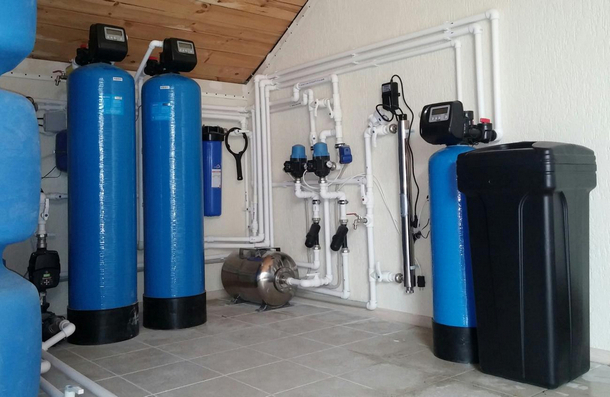
The main harmful impurities in water from any well are iron and hardness salts.
Rock particles and other undissolved fractions are removed without significant difficulty. For their detention, mechanical methods of processing incoming water with the required level of filtration are used. We will leave a detailed study of these technologies beyond the review. We only note the need for preliminary retention of these contaminants in order to reduce the load on the following components of the water purification scheme.
More difficult is the task of dealing with common substances (chemical compounds) that are contained in a dissolved state. They penetrate through mechanical barriers, so you will have to use special technologies to remove them.
Iron spoils things, dishes, plumbing. Dirty brown water cannot be used for drinking (no more than 0.3 mg / l according to SanPiN standards), hygiene procedures, car washing. This substance is converted by oxidation into rust particles. They can be delayed by a mechanical filter.
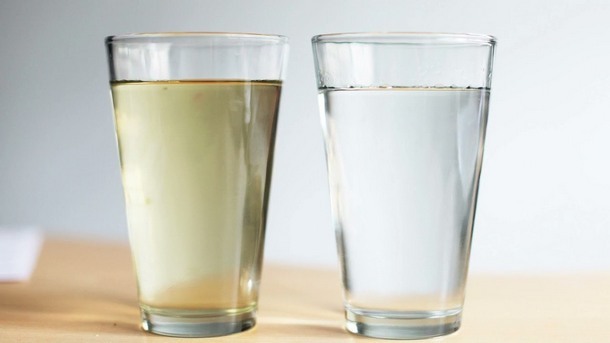
A similar purification method is used to remove manganese (not more than 0.1 mg/l). It worsens the organoleptic properties of water, stains it black. Without detailed explanation, it is clear that such a liquid is unsuitable for residents of a country house.
Magnesium and calcium salts (hardness) are the next most common harmful impurities. They do not change the color of water, but give a bitter taste at a concentration of 7 mg-eq / l. This level is the limit according to SanPiN.
Other troubles that arise even with a lower content are given in the following list:
- clogging of engineering communications;
- violation of heat transfer processes with a layer of scale;
- overheating damage to individual parts of connected household appliances;
- decrease in the effectiveness of shampoo, other detergents;
- deterioration of the functional state of hair and skin.
Hardness salts are not converted by oxygen into solid particles, so aeration is not suitable in this case. They are removed by synthetic resin loading, which performs an ion exchange treatment. An alternative method is also used - electromagnetic influence. It stops the formation of scale after the conversion of impurities, but does not function as a mechanical filter.
The best water treatment systems for a private and country house
Choosing a good equipment option is not as easy as it might seem from a superficial study of products for the corresponding purpose. Models presented in retail chains differ not only in price and performance. For their installation (maintenance), various methods are used that can cause difficulties for the average user. A comprehensive assessment of the characteristic pros and cons will help you buy equipment without errors.
1 place. electromagnetic
2nd place. hollow fiber
3rd place. Ion exchange
4th place. Cartridge
5th place. Reverse osmosis
electromagnetic
This system is not used for water treatment. Its functionality is determined by the power of the generator (the list indicates the minimum value of the parameter):
- blocking the formation of scale - 4 W;
- destruction of the old layer of deposits - 9 W;
- destruction of microorganisms (only in the zone of force impact) - 19 W.
The lower limit of the signal frequency is applied from 1kHz. Upper - up to 20-25 kHz. The wider the corresponding range, the more efficient the processing is.

Technology advantages:
- versatility - suitable for installing equipment in a private house, office, apartment;
- mobility - the ability to quickly dismantle to move to another object;
- economical consumption of electricity;
- long-term preservation of good working parameters;
- full automation of the processing process;
- preservation of the beneficial effect with severe water pollution - up to 25 mg-eq / l.
Insufficient efficiency manifests itself only when the characteristics of the device do not correspond to the values noted in the review. The most powerful high-quality equipment stops the formation of scale up to 1800-2000 meters from a working coil.
hollow fiber
These filters are designed as an alternative to reverse osmosis. The main difference is the membranes made of hollow fibers. Thick bundles are created from them, which provide an increase in the total diameter of the ducts. This feature explains the main advantage of the working module - high (from 900 l / h) productivity.
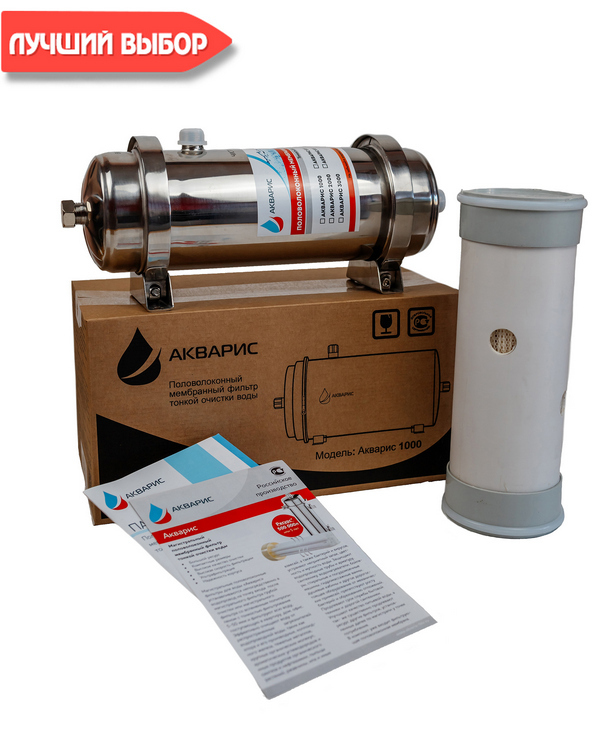
This device delays large particles between fibers. Small (from 0.01 microns) - do not penetrate through holes in the walls. Accumulated impurities are removed by washing. It is not necessary to add special reagents in this procedure.
Ion exchange
Water treatment systems of this category are often recommended for equipping a private house. Their popularity is due to the effectiveness of replacing calcium and magnesium components with sodium salts, which are not able to convert to scale.
For high-quality reproduction of the technical process, a volumetric loading layer is created. To ensure a flow rate of 1800 l/h, at least 45 liters of synthetic ion-exchange granules are required. The set includes a tank of 90-100 liters for the recovery solution.
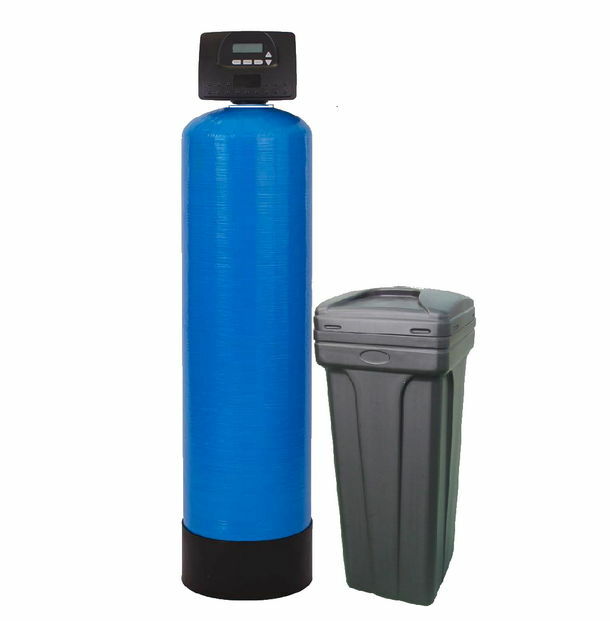
The large dimensions of the equipment is one of the characteristic disadvantages of the technology. When choosing this option, the following additional features should be considered:
- manual setting of the operating mode;
- preliminary removal of hydrogen sulfide, sulfides and abrasive particles;
- restrictions on suspended fractions and other water quality indicators set by the manufacturer;
- loud noise during flushing/regeneration.
Additional filters at the entrance increase the final price when buying a system. The total costs increase significantly if the laying of new lines of engineering networks is required.
Cartridge
Simple systems with a relatively low cost, are developed taking into account the lack of professional knowledge of ordinary users. To simplify the choice, customers are offered filters from hardness, mechanical impurities, iron and other impurities. A typical set is made up of several working modules. It includes fasteners, pipes, and other parts of the system. For self-assembly, a step-by-step instruction with explanations for the correct performance of individual work steps is added to the package of accompanying documentation.

The disadvantage of this choice is the frequent replacement of modules in case of severe water pollution. The resource according to the passport corresponds to indicators that do not exceed the norms of SanPiN.
Reverse osmosis
For household category systems, 10-11 l / h is considered a high processing speed. Only expensive models with two improved membranes are able to provide a performance of 25-40 l / h.
Other disadvantages include:
- electricity consumption to maintain the operating pressure at the inlet by the pump;
- increased water consumption, which, with separated contaminants, is sent to the drainage;
- complexity (high cost) of a set with a mineralizer, electronic control and other additional options.
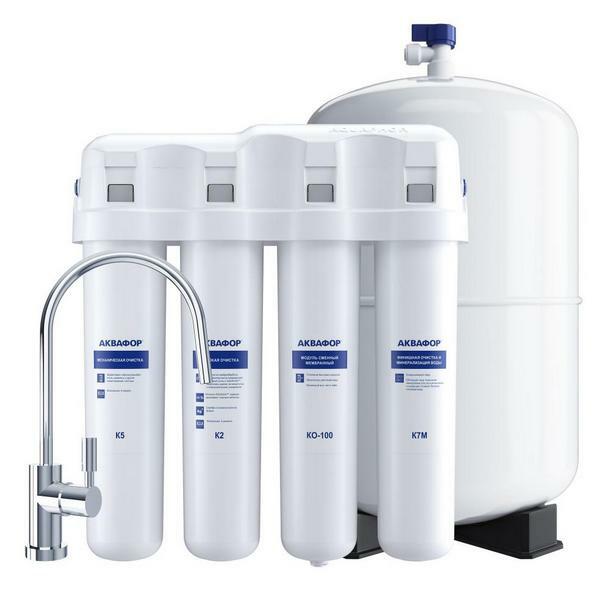
The high quality of filtration should be emphasized even when choosing the basic model of a reverse osmosis plant.
Ultraviolet (UV)
These systems destroy the DNA of viruses and bacteria with UV radiation (250-270 nm). They are highly effective in combating pathogens, but do not trap impurities. It is recommended to use these working modules together with mechanical filters.
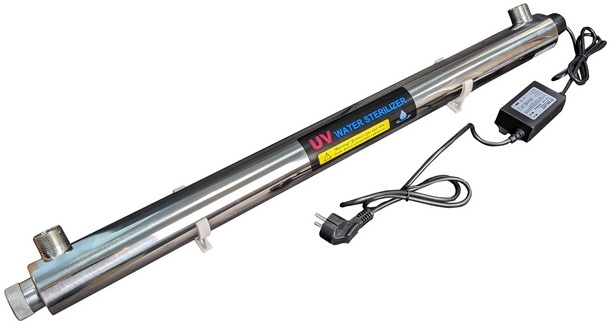
Schemes against rigidity
Reliable protection against scale will provide the following methods:
- reverse osmosis;
- ultrafiltration with a hollow fiber membrane;
- ion exchange;
- exposure to an electromagnetic field.
Features of technologies are considered in detail in the review. But you can use them together for more efficient treatment of water from a well.
A hollow fiber module, for example, is installed according to the connection scheme paired with an electromagnetic device. This solution stops scale formation, but only partially softens. A certain amount of dissolved minerals remains in drinking water, improving its quality. Microorganisms through the appropriate barrier do not penetrate.
Who to contact for the installation of a water treatment system
For the correct installation of equipment, turn to professionals. The services offered in this area are checked according to the following criteria:
- company reputation;
- having a license;
- cost and terms of performance of works;
- warranty obligations.
It is recommended to draw up a written contract in order to have at your disposal a mechanism for monitoring and satisfying claims against the contractor for the installation and maintenance of the water treatment system.
The best schemes against iron
From the descriptions of individual technologies, it is clear that their coordinated use in the complex ensures high quality of water treatment. To remove iron, apply:
- aeration - natural (spray) and forced (through a compressor);
- oxidation by catalytic loading - Birm, Pyrolox or similar;
- treatment with potassium permanganate, chlorine solution, other reagents.
After being converted to solid particles, impurities are removed by mechanical filtration.
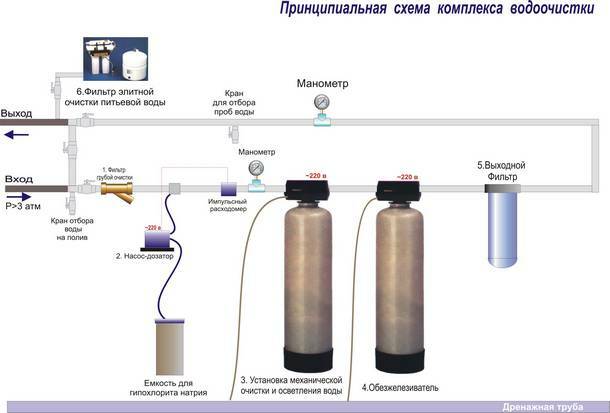
Prices
The cost of a water treatment plant depends on its composition. For a more accurate budget estimate, a project with a list of functional components is required. The range of costs in typical situations is from 40 to 160 thousand rubles. rubles.
Which system and water treatment plant is better to buy?
For the correct choice of equipment, use the results of water analysis. Based on the data obtained, criteria for evaluating the technical parameters of suitable working modules are established. Separately, compatibility with existing engineering communications is checked.
Summing up
In some parts of the review, the need to prepare a high-quality package of project documentation was emphasized. Professional advice will help to eliminate errors if the relevant work is carried out on their own. It is recommended to study the services of the seller. Some companies offer free design when purchasing functional system components from them.


